Sewing - Miscellaneous Items
All content copyright © 2010-2024 Frank Revelo, www.frankrevelo.com, United States copyright office registration number TX-7931345
Stuff sacks for tent stakes
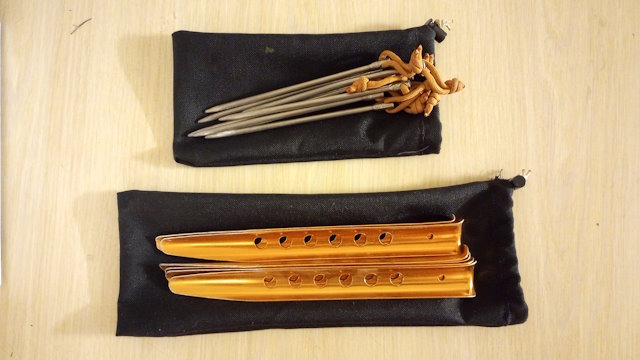
Materials: 1000d coated cordura, mini-cordlock, 2mm dacron cord, 90/14 needle.
Nail stake sack: Cut fabric 5.5 x 18". Finished size 4.5 x 8.5". 25 grams.
Sand stake sack: Cut fabric 5.5 x 27". Finished size 4.5 x 13". 35 grams.
Fold, stitch one side with 1/4" seam and zigzag seam allowances. 1/2" tunnel at top. Stitch open side with 1/4" seam and zigzag seam allowances. Install drawcord and cordlock.
Original design used 1.9oz/sqyd silnylon, but nail stakes wore through bottom of sack. So added cordura reinforcement to bottom. Then noticed abrasion of fabric at top of sack and worried about possible abrasion to tarp, since nail stakes stored in same stuff sack as tarp. Switch to cordura adds about 10grams to reinforced version of nail stake sack, which is justified, given seriousness of possible damage to tarp. Extra weight for sand stake sack is unimportant, since sand stakes only carried when bicycle touring.
Stick holder
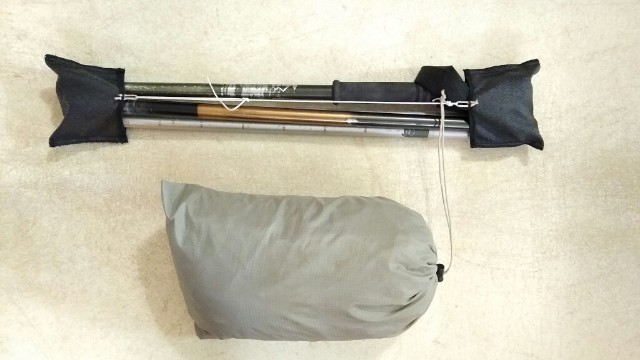
Cut 2 pieces 1000d Cordura 8" wide by 5" wide. Hems on 5" sides. Sew loop of guyline into hem. Fold to 4" long, stitch, zigzag edges. Connect by 24" of guyline. Securely attach tarp stuff sack to one pieces, so never lost and as reminder about rear tarp pole when packing up in morning. 20 grams.
Silnylon food sack
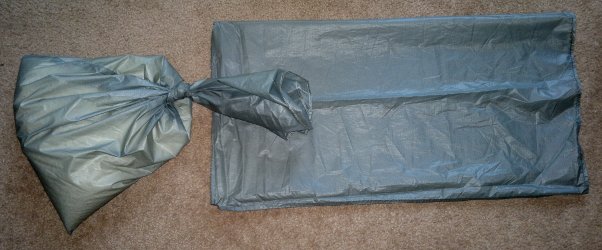
Left image above shows how sack is closed using overhand knot. Use 1.4 oz/sqyd silnylon fabric, 80/12 needle. Cut fabric 30" wide by 28" high. Fold along width, stitch bottom and side with 3/8" seams, zigzag seam allowances. Add 1/4" hem at top. Finished size 14.5" wide by 27" high. 25 grams.
Stuff sacks
Use 1.4 oz/sqyd silnylon fabric for ordinary stuff sacks, 80/12 needle. Cut fabric 20" by 16" for medium stuff sack, 19" x 9" for small, fold, stitch bottom and side with 1/2" seam, zigzag seam allowances. Buttonhole on side seam, 1/2" tunnel at top, install 2mm braided polyester drawcord and mini cordlock. Finished size/weight 9.5" x 15" and 13 grams for medium, 9" x 8" and 7 grams for small.
For medium stuff sack for holding insulated pullover to make pillow, use 3.3 oz/sqyd supplex nylon and 80/14 needle. 25 grams.
For large packliner stuff sack, use 1.6 oz/sqyd (1.9 oz/sqyd after coating) HyperD PU4000 silpoly from RipstopByTheRoll.com (shiny side is PU4000 coated and faces out, matte side is sil/PU and faces in). Cut 59" (width of fabric roll) by 20.5" and fold lengthwise (no seam on bottom, so water cannot seap in from bottom). Sew up one side with 1/4" seam, other side with 1/2" seam, zigzag seam allowances. Buttonhole along 1/2" side seam, 1/2" tunnel, install drawcord, cordlock not necessary. Finished size 20" wide by 29" high, 60 grams.
For stuff sacks for bicycle tools and spares, use 2.0 oz/sqyd heavyweight silnylon, 80/14 needle, heavier cordlock. Cut 20.5" by 17". Finished size 9.5" wide by 16" high, 23 grams.
Cases for can opener, mirror, tools
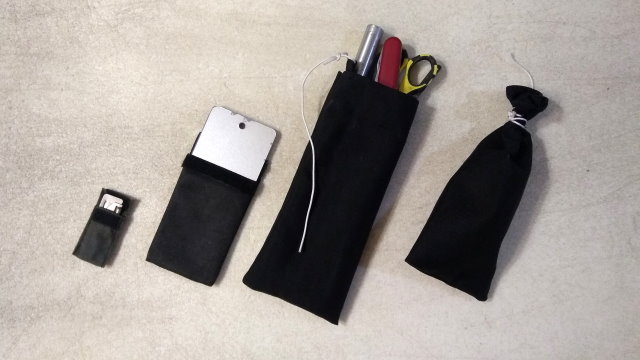
Can opener case fits Coghlan's brand P-51 (some people mistakenly call it P-38) military-style can opener, ordered from REI or Campmor. Can opener weighs about 7 grams and case weighs about 3 grams, so combination weighs about 10 grams. Use heavy coated oxford cloth (same fabric used for bottom of backpack). Cut 5.5" by 1.75", 1/8" hems on all sides, add 1/2" strips of hook-and-loop at either end, fold and stitch.
Mirror case fits the Coghlan's 2.75"x4.25" acrylic mirror sold at REI, Campmor and elsewhere. Cut 1000d cordura 4" wide by 11" high. 1/8" hem on both ends. Attach 3" long loop side of 1/2" velcro to right side of fabric at one end. Fold along height, leaving 1" flap, stitch with 3/8" seams. Trim seam allowances to 1/4" and zigzag. Turn inside out and sew hook side of 1/2" velcro to flap. 10 grams.
Tools case holds scissors, tweezers, nail fail, tooth scraper, folding knife, inclined rowing handle, other tools that might cut or abrade stuff sack (or neck purse when carrying tools in city). Cut 1000d cordura 9" wide by 10" high. 1/4" hem on one 9" side. Fold to 4.5" x 9.5" and double stitch unhemmed edges with .25" seam. Double zigzag seam. Fold 1" x 2" strip of cordura to .5" x 2", zigzag edges, fold into loop, stitch to inside hem of case, attach 12" guyline to loop (used to tie shut). Fray check internal stitching, turn inside out. 20 grams.
Blaze orange hat cover
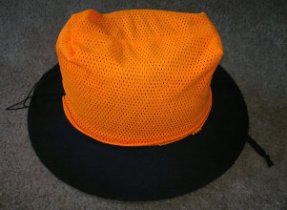
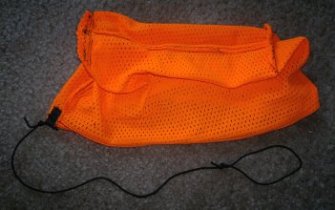
Right image above show inside of hat cover, including keeper cord that secures hatcover to hatband. Made of polyester mesh (from owfinc). Cut 23" wide x 8" high. Fold along width, sew up sides and top with 1/2" seam, zigzag edges. Square-off bottom into rectangle 3" wide x 8" long with 1/2" seam allowances, trim excess, zigzag edges. Hem bottom. Attach loop of 1/2" wide grosgrain nylon to back/bottom seam. Attach 24" of cord to this loop, used to secure cover to hat so it isn't pulled off accidentally when snagging on overhead branches. 15 grams.
No-see-um headnet
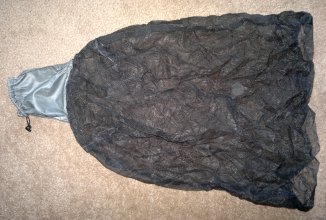
Cut two pieces of no-see-um netting 27.5" long by 21" wide, sew together on three sides with 5/8" seam, square off bottom using 5/8" seam to form open-ended sack 22" long by 10" square. Make extra-small stuff sack (cut silnylon 11" wide by 6" high, see sewing instructions for stuff sacks above). Sew inside bottom of stuff sack to inside top seam of headnet, so stuff sack will not get lost. 25 grams, including stuff sack.
Sleep hat
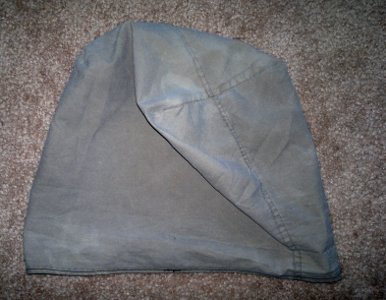
Cut 3-ply supplex nylon 25.5" wide by 13" high, fold along width, stitch top and side with 1/2" seam allowance, trim and zigzag seam allowances. 1/2" hem at open side. Square off bottom (6" square) with 3/8" seam allowance, zigzag seam allowance. 20 grams.
Sleeve extensions
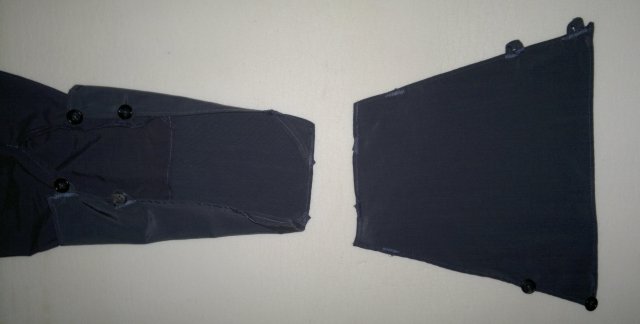
During 2012 Nevada backcountry bicycle tour (no tree cover and constant sun), I experienced some burning on backs of hands, which is why I designed these sleeve extensions. Much cooler than gloves, but give almost equivalent protection from sunburn. During 2014 tour, I went shirtless while bicycle touring Nevada and experienced no pain. So evidently, all I need is good base tan and then I am immune to sunburn, at least at Nevada latitudes in September/October. So I no longer carry these sleeve extensions. They might be useful for people who don't tan as well as me. About 25g grams if made with 3-ply supplex nylon.

Use same fabric, buttons, thread as shirt. Cut scrap of fabric 1" wide, doubly-fold and topstitch, so that finished size is about 1/4" wide. Cut 4 strips 2.25" long (button loops) and 2 strips 2.75" long and 2 strips 3.25" long (finger loops). Cut 2 pieces of fabric as shown in above pattern. 1/4" hems on all sides. Sew buttons and button-loops to match those on shirt. Note that sleeve extensions for right and left sleeve will normally be mirror images of one another, depending on how buttons where sewed onto shirt. Sew finger loop strips at diagonal on front part of sleeve extension. Longer finger loop is for index finger, shorter loop is for little finger. Apply fraycheck to bartacks.